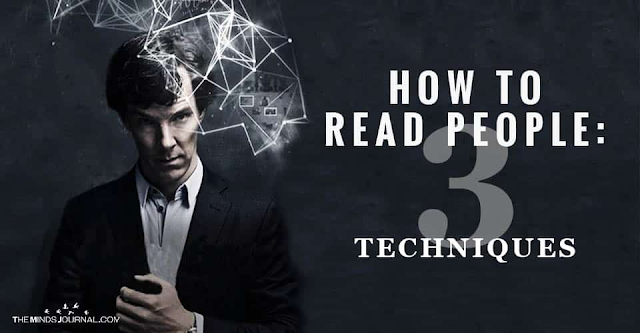Using Your Super Senses to Read People: 3 Techniques
My role as a psychiatrist is to read individuals, to understand who they are in addition to what they say. I want to peek past their masks and into the true person through deciphering verbal and nonverbal signs. Using logic alone won't give you a complete picture of somebody. To learn to read the crucial non-verbal intuition signs that individuals give out, you must submit to other essential sources of information. You must also be willing to let go of any preconceived notions or emotional baggage, such as long-held grudges or ego-clashes, that prevent you from seeing someone clearly in order to do this.
The key is to remain objective and receive information neutrally without distorting it.
3 Techniques to Read People
1. The First Technique – Observe Body Language Cues
1. Pay Attention to Appearance
When reading others notice: Are they wearing a power suit and well-shined shoes, dressed for success, indicating ambition? Jeans and a t-shirt, indicating comfort with being casual? A tight top with cleavage, a seductive choice? A pendant such as a cross or Buddha indicating spiritual values?
2. Notice Posture
When observing someone's posture, consider whether they are holding their heads high and seem confident. Or do they stroll unsure of themselves or huddle in fear? Do they carry themselves with a cocky swagger and a puffed-up chest?
3. Watch For Physical Movements
b) Crossed arms and legs
This posture hints at self-defense, rage, or defensiveness. People often cross their legs with the toes of the top leg pointing in the direction of the person they feel most comfortable with.
c) Hiding one’s hands
People often give the impression that they are concealing something when they put their hands in their pockets, laps, or behind their backs.
d) Lip biting or cuticle picking
People who bite, lick, or pick at their cuticles do it in an effort to calm themselves when under stress or in an uncomfortable circumstance.
4. Interpret Facial Expression
Our faces can permanently display our emotions. Deep frown lines imply worry or excessive thought. Crow's feet are the joyful grin lines. Lips pursed indicate rage, disdain, or resentment. Teeth grinding and a clinched jaw are indications of strain.
2. The Second Technique – Listen to Your Intuition
Beyond their words and body language, you can read someone. What you feel in your stomach, not what your intellect tells you, is intuition. Instead of using logic, you are perceiving nonverbal knowledge through visuals, "ah-has," and physical knowings. The most important factor in understanding someone is their true nature, not their outward appearance. Your intuition will help you see beyond the obvious to uncover a deeper narrative.
Checklist of Intuitive Cues
1. Honor your gut feelings
In particular during initial meetings, when a visceral reaction happens before you have a chance to think, pay attention to what your gut says. It indicates your level of comfort. Gut reactions are fast and primitive in nature. They serve as your personal truth gauge, helping you decide who to believe.
2. Feel the goosebumps
Goosebumps are wonderful intuitive tingles that let us know when someone is moving or inspiring us, or when they are expressing something that resonates with us. Deja-vu, or the feeling that you know someone even though you haven't met them, can also give you goosebumps.
3. Pay attention to flashes of insight
In conversations, you may get an “ah-ha” about people who comes in a flash. Stay alert. Otherwise, you might miss it. We tend to go onto the next thought so rapidly these critical insights are lost. So, pay attention when you read people.
4. Watch for intuitive empathy
It is a powerful sort of empathy when you can occasionally physically sense the physical signs and feelings of other individuals. Therefore, when interpreting others, pay attention to things like, "Does my back hurt when it didn't before? "Am I depressed or upset after an unproductive meeting? "Ask for feedback to discover if this is empathy.
3. The Third Technique – Sense Emotional Energy
Strategies to Read Emotional Energy
1. Sense People’s Presence
This is the total energy we give out, which may or may not match our words or actions. It is the emotional environment that surrounds us, similar to a cloud or the sun. Do they exude a welcoming atmosphere that draws you in as you read? Or are you trembling and reversing course?
2. Watch people’s eyes
Strong energy are transmitted through our eyes. Studies show that the eyes also emit an electromagnetic signal that extends outside of the body, just like the brain does. Spend some time observing how people look. Do they seem worried? Sexy? Tranquil? What Does That Indicate? angry? Find out if they appear to have a partner at home by observing their eyes. Or do they appear guarded or concealed?
3. Notice the feel of a handshake, hug, and touch
Through physical contact, we transfer emotional energy, much like an electrical current. Does a hug or handshake seem cozy, at ease, and assured? Or is it repulsive enough that you wish to distance yourself? Are hands clammy and indicating anxiety? Or is it limp, implying reticence and timidity?
4. Listen for People’s Tone of Voice and Laugh
Our voice's volume and tonality reveal a lot about our emotions. Frequencies of sound cause vibrations. Consider how a person's tone of speech impacts you when reading them. Do you feel comforted by their tone? Or is it rude, sarcastic, or whiny?
Read Article:




Comments
Post a Comment